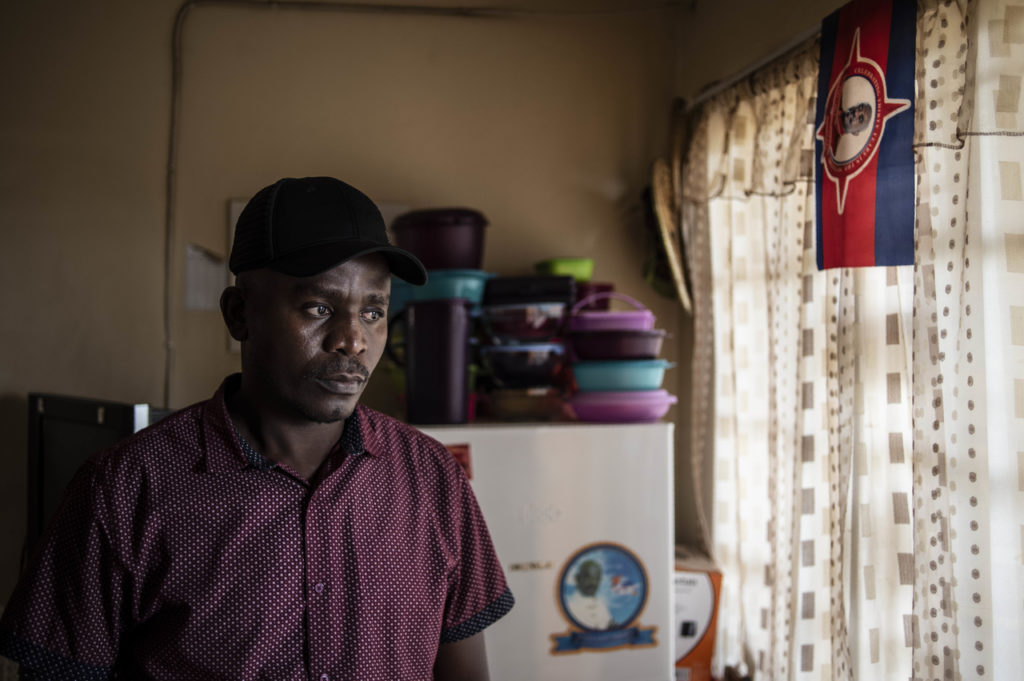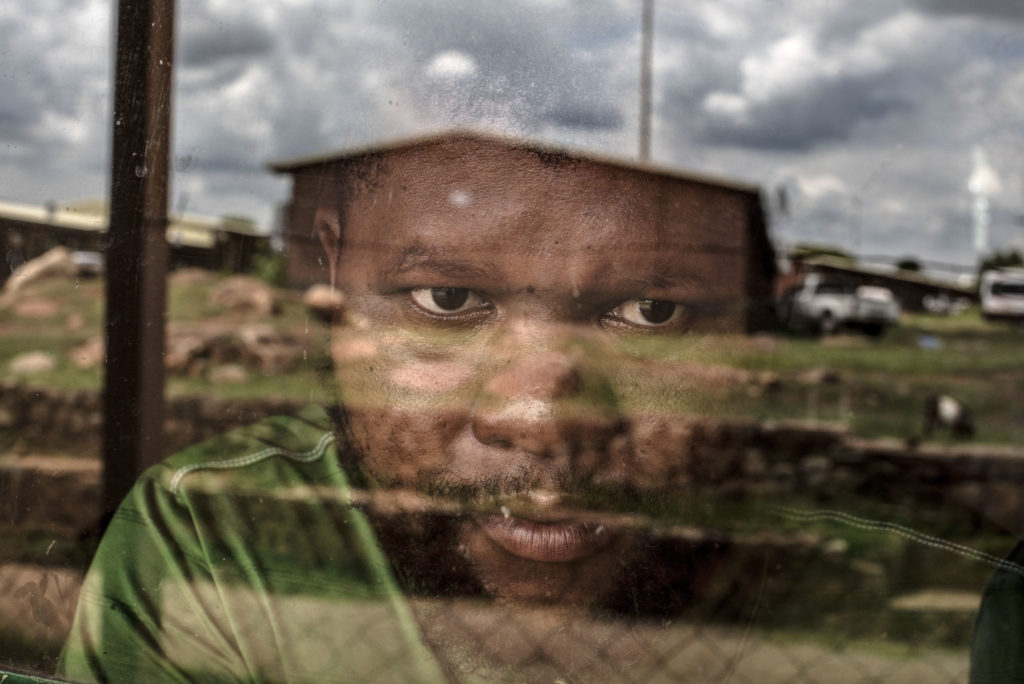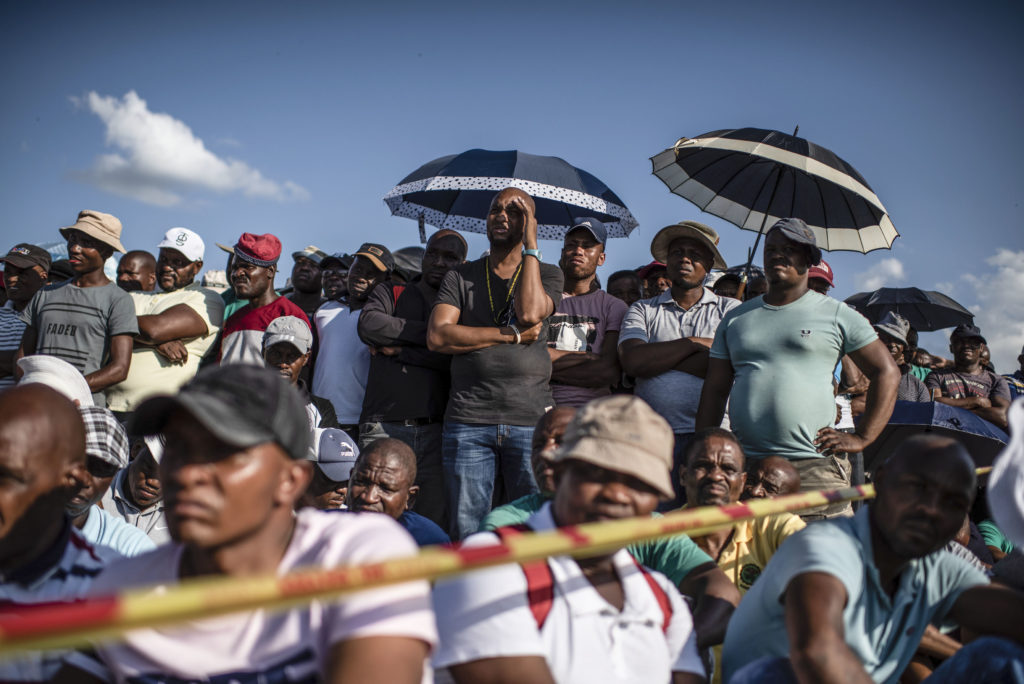Fighting for their rights: Amcu president Joseph Mathunjwa addressing mineworkers about the recent retrenchments at Sibanye. (Paul Botes/M&G)
Lungisile Madwantsi has a bullet lodged in his head. If it is removed he could die. He is not fit to work.
He is one of many former Lonmin mineworkers who were shot and injured on August 16, eight years ago. Lonmin kept him as an employee, even though he cannot work. Now, he says all of this is about to change.
Madwantsi and others claim that the mining group Sibanye-Stillwater wants to renege on the long-standing agreement the mineworkers had with Lonmin to continue to pay workers who had been injured at Marikana without them needing to work, as their injuries were debilitating.
“Sibanye told me that I have to undergo a medical examination to ascertain where I could best be placed to work. That is crazy. Look at me,” says Madwantsi. He fixes his sitting position on a blue plastic chair and takes his cane to point to his left leg, which still will not work properly, years after the massacre.
 Lungisile Madwantsi was injured in the 2012 massacre. Now he fears he may lose his pay under new owners Sibanye. (Paul Botes/M&G)
Lungisile Madwantsi was injured in the 2012 massacre. Now he fears he may lose his pay under new owners Sibanye. (Paul Botes/M&G)
His former colleague who has been in the same predicament, Elias Mtengwane, says he completed his examination on Tuesday after three days of trying to do so. Mtengwane was shot in his groin area.
“Amasende am ayavuza nje bendisa ngapha nangapha [my testicles are leaking as I am sent from pillar to post]. Sibanye wants me to prove that I am sick enough for them to continue paying me,” says Mtengwane.
Mzoxolo Magidiwane, another injured mineworker, explains that back in 2012, after they had been discharged from hospital and were expected to go back to the mine, he asked his lawyers to approach Lonmin.
“The agreement was that the company would continue paying us and put us in the mine flats. This would continue until we were fit to go back to work or were of retirement age. There is no way we can be expected to go back underground,” says Magidiwane.
 Mzoxolo Magidiwane was also injured in the 2012 massacre. (Paul Botes/M&G)
Mzoxolo Magidiwane was also injured in the 2012 massacre. (Paul Botes/M&G)Being underground makes him retch. The smell of burned dynamite, he says, takes him back to the firing line eight years ago. The smell of the bullets reminds him of the burn he felt when he was shot in his groin area and his legs by police officers eight years ago.
“Going underground again is not an option. But we want to feed our families. If I could work again I would. But how Sibanye is going about this is unfair,” he says.
Magidiwane says that he was contacted by the mine’s HR department, which informed him that he had to take a medical examination. “I was told that if I fail I am gone and if I pass I am going back underground.”
He took the examination while he was meant to be on leave. “I felt forced to take this medical examination because I was told that if I don’t, I will not get my salary. Essentially, what they want is to find us a place to work or force us out,” he says.
The three men feel anxious about Sibanye’s intentions.
James Wellsted, the senior vice-president of investor relations at Sibanye, says that there has been a miscommunication with the group of former mineworkers.
He says that the company wants to ascertain the wounded men’s “current health and wellness status and whether the care that has been provided for their injuries is sufficient or whether they may require additional medical attention”.
He adds that Sibanye had offered the employees transport that would take them to the medical examinations. But Mtengwane and Madwantsi say they have been transporting themselves, with great difficulty, to and from the hospitals, where they have been sent from pillar to post.
Mtengwane says: “On the second occasion I went to the hospital the doctor who is meant to conduct this [examination] was not there and no one knew when he would be back. I live in pain but what hurts the most is that I have no choice. I can’t say ‘no I won’t do this.’”
Amid all the uncertainty and miscommunication, thousands of Sibanye workers have been laid off, heightening the apprehension of the wounded men.
Just two months after Sibanye, now the world’s second-largest platinum producer, took over the mine it began consultations about culling more than 5 000 jobs. Last week, Sibanye announced that the final figure of retrenched workers was far smaller than anticipated, with 1 142 employees leaving the company.
On Monday afternoon, the majority union — the Association of Mineworkers and Construction Union (Amcu) — held a mass meeting in Marikana. Its president, Joseph Mathunjwa, was scathing about Sibanye, as he told the workers that there is nothing the union could do to stop the retrenchments.
 Mineworkers listening to an address from Amcu president Joseph Mathunjwa. (Paul Botes/M&G)
Mineworkers listening to an address from Amcu president Joseph Mathunjwa. (Paul Botes/M&G)
“We did all we could. We fought as much as we could. In December whilst people were enjoying Christmas with their families we were busy talking to lawyers to see if there is anything we could do to save more jobs; there is nothing more.”
Although the retrenchment process seems to have been finalised, Madwantsi is worried that the mine still wants to cull more workers and the injured workers are on the chopping block. “I have not been able to undergo my medicals because the mine hospitals have misplaced my files and though I keep on being sent from pillar to post no one can find it, but they want me to do a medical exam,” he says. “Something is just not right here.”
Amcu’s Rustenburg region co-ordinator, Patrick Moepadira, confirms that the union is dealing with the matter of forced medical examinations. “We have asked the comrades to undergo these medicals and we will take it from there. We are dealing with this internally but we will not allow for our members to be mistreated in any way,” he said.
Meanwhile, Wellsted adds that Sibanye would be in contact with the mineworkers as it “sympathises with the employees who are no doubt experiencing significant uncertainty and worry as a result”.